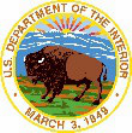
1
United States Department of the Interior
COVID-19 Workplace Safety Plan
Version 8.0
May 31, 2024
2
I. Introduction ...................................................................................................................... 3
II. Purpose ............................................................................................................................. 3
III. Background ....................................................................................................................... 4
IV. Scope & Applicability ......................................................................................................... 4
V. COVID-19 Safety Protocols ................................................................................................ 4
A. Reporting Requirements ............................................................................................... 4
B. Vaccinations .................................................................................................................. 5
C. Hygiene ......................................................................................................................... 5
D. COVID-19 Testing .......................................................................................................... 6
E. Entry into Department of the Interior Workplaces When Sick ...................................... 6
F. Masks ............................................................................................................................ 7
G. Physical Distancing ........................................................................................................ 7
H. Travel ............................................................................................................................ 7
I. COVID-19 Workers’ Compensation Claims .................................................................... 8
J. Facilities and Safety ....................................................................................................... 8
K. Collective Bargaining Obligations .................................................................................. 9
APPENDIX A–Summary of Document Version and Changes .................................................... 10

3
I. Introduction
The Department of the Interior (the Department) is committed to addressing essential public
health and work requirements consistent with best public health practices. The principles
presented are based on the latest guidance from the Centers for Disease Control and Prevention
(CDC), the Occupational Safety and Health Administration (OSHA), and other Federal agency
guidelines. This Department of the Interior COVID-19 Workplace Safety Plan (Plan) will be
reassessed over time, to address broader pandemic preparedness or other workplace safety issues.
II. Purpose
The Department maintains a robust response and recovery coordination system that has been
institutionalized and used for over 15 years to manage and coordinate disaster response and
recovery efforts across multiple different disasters and pandemics.
The Department’s Pandemic Plan provides functional descriptions of each element of the
Departmental Response Coordination. Departmental Response Coordination efforts include
convening various Councils and Task Force components when a pandemic threatens or impacts
multiple Bureaus and Offices or requires significant Departmental involvement.
Since 2021, the Department of the Interior’s COVID-19 Workplace Safety Plan has served as a
framework for the Department’s efforts to maintain a safe and healthy workplace due to the risk of
COVID-19 transmission. While the authority requiring the development and maintenance of
Federal agencies’ Workplace Safety Plans has shifted throughout the course of the COVID-19
pandemic, as of April 12, 2024, Federal agencies have been instructed to follow the requirements
of Executive Order on COVID-19 and Public Health Preparedness and Response and
Memorandum 24-12 issued by the Office of Management and Budget (OMB). This includes the
requirement to continue to maintain, update, and implement Federal agency COVID-19 Workplace
Safety Plans, and to notify OMB when Plan are revised.
As such, the purpose of the Department of the Interior’s Workplace Safety Plan is to outline the
Department’s longer-term response to COVID-19, including providing safety protocols based on
best practices to reduce the incidence of COVID-19 in Department of the Interior workplaces, and
to outline the Department’s approach to pandemic preparedness in general.

4
III. Background
The overarching goals of the Department of the Interior’s COVID-19 Workplace Safety Plan are to:
A. Continue to prevent the spread of COVID-19 by relying on the best available data and science-
based public health measures;
B. Prioritize the health and safety of the federal workforce, contractor employees, and visitors;
and
C. Sustain the mission of the Department and mitigate the impact to the environment, natural
resources, economy, and the functioning of society.
The protocols listed in this document are based on requirements from federal agencies including
OSHA, the Office of Personnel Management (OPM), OMB, and CDC. It is important to note that in
2024, the CDC’s general public health information and guidance related to COVID-19 also addresses
the prevention of other circulating respiratory viruses, such as influenza and respiratory syncytial
virus. While CDC’s guidance broadly addresses respiratory viruses, it is applicable to the prevention
of COVID-19.
IV. Scope & Applicability
This policy applies to all Bureaus and Offices within the Department of the Interior.
V. COVID-19 Safety Protocols
The Department of the Interior is committed to addressing essential work requirements consistent
with public health best practices. The Department’s paramount concern is the health and safety of
all federal employees, onsite contractor employees, official visitors, members of the public, and
individuals interacting with the federal workforce. As of May 31, 2024, the following COVID-19
safety protocols remain in effect in Department of the Interior workplaces:
A. Reporting Requirements
1. OSHA Reporting Requirements
Under OSHA’s recordkeeping requirements, if an employee tests positive for COVID-19, and each
of the following conditions are met, the case must be reported in the Departments Safety
Management Information System (SMIS) to be recorded on the Department’s OSHA Illness and
Injury Log: (1) the case is a confirmed case of COVID-19 (as defined by CDC); (2) the case is work-

5
related (as defined by 29 C.F.R. § 1904.5); and (3) the case involves one or more relevant
recording criteria (set forth in 29 C.F.R. § 1904.7) (e.g., medical treatment beyond first aid, days
away from work or restricted duty).
B. Vaccinations
Department of the Interior employees are not required to become vaccinated against COVID-19.
The Department encourages, but does not require, employees to review and follow CDC
guidance related to COVID-19 vaccinations
1. Human Resource Flexibilities to Obtain a COVID-19 Vaccine
To encourage employees to voluntarily obtain doses of updated COVID-19 vaccines,
administrative leave (pay code 060) may be granted for eligible employees to obtain an FDA-
approved or FDA-authorized COVID-19 vaccine dose (including boosters) during work hours.
Employees whose COVID-19 vaccination appointment(s) fall within their regularly scheduled
tour of duty should obtain advance approval from their supervisor before using administrative
leave for purposes of obtaining a COVID-19 vaccine dose (generally, not to exceed four hours
per dose). The administrative leave will cover the time it takes to travel to the vaccination site,
receive the vaccine dose, and return to work. If an employee needs to spend less time getting
the vaccine dose, only the needed amount of administrative leave should be granted. The use
of administrative leave to obtain each dose of an FDA-approved or FDA-authorized COVID-19
vaccine is subject to supervisory discretion and operational needs. Employees may not be
credited with administrative leave or overtime work for time spent obtaining a vaccination
outside their duty hours. Administrative leave granted under this section must comply with
applicable laws and Departmental policies.
Questions and concerns related to human resources flexibilities should be directed to the
Bureau or Office’s servicing Human Resource Office (SHRO).
C. Hygiene
Hygiene, or practices that improve cleanliness, is a core prevention strategy to lower risk from
COVID-19. The Department encourages, but does not require employees to follow CDC guidance
as it relates to practicing good hygiene by:
• Covering coughs and sneezes,
• Frequently washing or sanitizing hands, and

6
• Cleaning frequently touched surfaces in their office and workspace.
Managers are also encouraged but not required to:
• Post free hygiene posters from CDC and displaying them in highly visible areas,
• Ensure facilities are equipped with soap, water, and a way to dry hands (for example,
paper towels or a hand dryer),
• Place hand sanitizer dispensers with at least 60 percent alcohol near frequently touched
surfaces and in areas where soap and water are not easily accessible, such as near
elevators, shared equipment, and building entrances and exits, and
• Adopt cleaning protocols to clean frequently touched surfaces, such as countertops,
handrails, and doorknobs regularly.
D. COVID-19 Testing
The Department does not require mandatory COVID-19 testing. The Department encourages,
but does not require, employees to visit CDC’s website for additional information and discuss
testing options and limitations with their healthcare provider to best inform prevention or
treatment choices relevant to COVID-19.
Bureaus and offices are generally not authorized to regularly purchase and distribute FDA
approved and authorized COVID-19 tests to employees, contractors, and visitors. In
circumstances where the provision of test would be beneficial to the Department (i.e., reducing
transmission or preventing an outbreak from occurring, force readiness), tests may be
purchased and provided to the relevant stakeholders.
In some cases, Workers’ Compensation may provide certain medical benefits (i.e., reimburse
employees for the costs of test), however, employees should always consult their Workers’
Compensation Specialist for additional information and eligibility criteria related to Workers’
Compensation benefits.
E. Entry into Department of the Interior Workplaces When Sick
Any employees who are currently sick with a contagious, communicable disease should not
enter Department of the Interior workplaces.
The Department encourages, but does not require, employees to consult CDC guidance or a
healthcare provider for additional information.

7
F. Masks
The Department does not require employees to wear masks in Department of the Interior
facilities, lands, or workplaces as a COVID-19 preventative action. The Department encourages,
but does not require, employees to consult CDC mask guidance to protect themselves and
others from COVID-19.
Bureaus and offices are generally not authorized to regularly purchase and distribute high-
quality masks to employees, contractors, and visitors. In circumstances where the provision of
mask would be beneficial to the Department (i.e., reducing transmission or preventing a known
outbreak from occurring, force readiness), masks may be purchased and provided to the
relevant stakeholders.
G. Physical Distancing
Employees are not required to physically distance within workplaces. The Department
encourages, but does not require, employees to consult CDC physical distancing guidance to
protect themselves and others from COVID-19.
H. Travel
There are no Government-wide limits on official travel (i.e., travel conducted under an official
travel authorization) to prevent the transmission of COVID-19. The Department encourages all
employees traveling on official Department business to follow the general COVID-19 safety
recommendations in this Plan before, during, and after official travel (i.e., travel conducted
under an official travel authorization).
If an employee experiences symptoms consistent with COVID-19 or is diagnosed with COVID-19
while on official travel, they should consult with their travel preparer and Bureau and Office
leadership for approvals to extend lodging and meals and incidental based on the provisions in
the emergency travel regulations at 41 CFR 301-30.
Additionally, when applicable, all employees should follow the travel policy of any agency
sponsoring their official travel.

8
I. COVID-19 Workers’ Compensation Claims
Employees and volunteers who suffer an injury proximately caused by exposure to COVID-19
may be eligible to receive workers’ compensation benefits under the Federal Employees’
Compensation Act. The injury must have occurred while the employee was in performance of
their federal duty. Please refer to FECA Bulletin No. 23-02 Processing Claims for COVID-19
Diagnosed after January 27, 2023 for information regarding workers’ compensation testing,
medical documentation requirements, and filing deadlines.
For more information, contact the Bureau or Office Workers’ Compensation Specialist.
J. Facilities and Safety
1. Signage
The posting of COVID-19 or Hospital Admission Level signage is no longer required in
Department of the Interior facilities and workplaces, however managers may consider
posting free hygiene posters from CDC and displaying them in highly visible areas,
2. Meetings, Events, and Conferences
There are no Department-wide restrictions for Department-hosted meetings, events, and
conferences as a COVID-19 preventative action.
3. Occupancy
Bureaus and Offices should not establish facility-level occupancy limits solely for the purpose
of facilitating physical distancing as a COVID-19 preventative action.
4. Ventilation & Air Filtration
The Department recommends that Bureaus and Offices take steps, as outlined by CDC to
improve indoor air quality. This includes:
• Ensuring existing HVAC systems are providing at least the minimum outdoor air
ventilation requirement in accordance with ventilation design codes. Applicable codes
are based on the year of building construction or latest renovation and intended building
occupancy.
• Aiming for five or more air changes per hour (ACH) of clean air. This can be achieved
through any combination of central ventilation system, natural ventilation, or additional
devices that provide equivalent ACH to your existing ventilation.

9
Facility Managers at each indoor Department facility should consult with building engineers
and their servicing safety office/manager to assess, make, and maintain improvements to
the facility’s ventilation and air filtration systems. Modifications should always be
documented in the approved facility-level plan to ensure that recommended upgrades are
implemented.
5. Cleaning and Disinfection
Standard office cleaning operations should continue on normal schedules with the potential
need for enhanced cleaning or disinfection if an individual was obviously ill. Bureaus and
Offices should ensure all employees and contractors who use cleaning chemicals and
disinfectants are properly trained on the hazards of the cleaning chemicals used in the
workplace in accordance with OSHA’s Hazard Communication standard (29 C.F.R. §
1910.1200, et seq.) and that all employees and contractors utilize appropriate personal
protective equipment in accordance with OSHA requirements and Department
policy. General guidance for cleaning and disinfecting can be found on CDC’s website.
K. Labor-Management Obligations
Bureaus and Offices will continue to satisfy any applicable labor-management obligations as
required by applicable laws, rules, and regulations.

10
VI. APPENDIX A–Summary of Document Version and Changes
• 5/2024 Version 8.0: Updated to align with updated EO and OMB Memorandum 24-12.
• 5/2023 Version 7.0: Update to align with end of the federal COVID-19 Public Health Emergency and the
President’s rescinding of EO 14042 and EO 14043.
• 1/2023 Version 6.0: Updated to align with SFWTF’s updated Model Agency Safety Principles.
• 8/2022 Version 5.0: Updated to reflect SFWTF’s changes related to meetings and conferences, physical
distancing, close-contact exposure, testing, self-isolation, masks, and travel.
• 08/19/2022 Version 4.0: Updated to reflect SFWTF’s changes related screening testing, quarantine,
physical distancing, attestation, and testing.
• 08/02/2022 Version 3.0: Updated to reflect SFWTF’s changes related to exceptions, leave, mask-
wearing, official travel, testing, contractors, quarantine, isolation, symptom screening, vaccinations,
and visitors. Update to align with CDC’s recent guidance on isolation, testing, masking, vaccination
status, quarantine, travel, COVID-19 Community Levels, the nationwide preliminary injunctions
enjoining agencies from implementing or enforcing EO 14043 and EO 14042, incident response, and
mission critical guidance.
• 12/10/2021 Version 2.1: Updated language about Executive Order 14042 and court orders and CDC’s
guidance related to testing and symptom monitoring.
• 12/03/2021 Version 2.0: Added vaccination requirements, exemptions, added information from OMB
Self-Assessment checklist. Updated entire Plan to align with latest SFWTF guidance related to
attestation, diagnostic testing, levels of transmission, vaccination requirement, reasonable
accommodations, masking, and physical distance requirements throughout Plan. Changed format to
improve readability.
• 7/29/2021 Version 1.3: Update to mask wearing guidance for vaccinated personnel.
• 7/23/2021 Version 1.2a: Updated table.
• 7/20/2021 Version 1.2: Updated quarantine and isolation, occupancy, visitors, and shared spaces to
align with OMB Memorandum M-21-25.
• 6/4/2021 Version 1.1: Updated URL links, various nomenclature, and revised document to remain
consistent with CDC’s mask, travel, physical distancing, testing, cleaning and disinfecting guidelines,
and SFWFT FAQs and directive.
• 6/4/2021 Version 1.0: Updated to maintain consistency with COVID-19 Workplace Safety and Health
Risk Reduction Guidelines, the Department’s COVID-19 Testing Guidance, the Department’s Employee
Guidance for Domestic Travel, Recommendations for Mitigations and Managing COVID-19 Exposures
and Illness in Shared and Congregate Housing, the Department’s COVID-19 Testing Guidance, the
Department’s Updated Vaccination FAQs for Managers and Supervisors, and mask wearing guidance
for vaccinated personnel.
